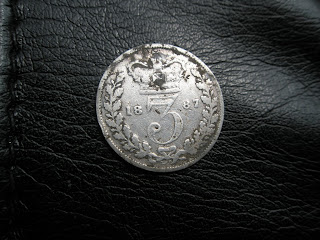This is the day where our modern line of stones was photographed and planned. As usual we gave the context a clean with trowels to remove any loose soil or stones from the surface so everything is clear for the photograph. If you take a look at our cleaned wall, then go back and have a look at Day 3 where we start to see the top of this wall come through, it gives a good indication of how the excavation progresses over time and how our understanding of the features we have develops.
While we were cleaning up the edges of the stones Rebecca, one of our volunteers, found a part of a thimble. This is very interesting as it appears to be quite early in date yet in a layer of mainly post medieval finds. It may have been redeposited or reworked in the soil to be found by us today! More on that in the small finds section at the end.
Back onto the recording of the stones. We usually use two methods of recording. The first one is using a planning frame, which is placed onto the area being recorded in line with the site grid, we used a tape and nails to mark where the planning frame needed to go.

The frame is made up of squares which enable us to look over the top of it and see what is visible in each square, then transfer that onto our paper. The paper we use is called permatrace, its a bit like thick tracing paper and enables us to draw even when its raining, we also use specific pencils, a 6H or higher stops the pencil from smudging or running in the rain. The other method of planning is called offsetting. We measure off a tape along our gridlines at a right angle using a hand tape and position it over what we are trying to record using a plum bob. We take lots of point measurements and mark them on the permatrace then join them up later like a big dot to dot. This method is good for outlines of pits or postholes and ditches. Planning frames are better for cobbles, stones or areas where there is a lot going on. Below is a picture of our planing frame over the stones.
Small finds
As I mentioned earlier, we found a piece of thimble today on the south side of the line of stones we recorded. There are two photos underneath for you to have a look at. As you can see the thimble is a ring thimble as opposed to a closed or 'domed' thimble. Ring thimbles are usually earlier than the closed kind and are used for heavier work than the closed kind. Ring thimbles are found in British contexts from generally about 1450.

While I am not a thimble expert, the indentations in this thimble do not look to be particularly large to me. The indentations usually show what type of work the thimble was used for - small holes go with narrow gauge needles for fine work and light fabrics. With this being a ring thimble associated with heavy work, we would expect the indentations to be large. As I say, I am no expert, maybe someone can tell me whether these are large or small indentations but they don't look that large to me. Either way though a very nice find, and from a context associated generally with much later finds.















 You may also be surprised to find out that this was how the coin came out of the ground. It
You may also be surprised to find out that this was how the coin came out of the ground. It  These photos below are some of the bulk finds which have been found over the three days. They include various iron objects, animal remains and pottery
These photos below are some of the bulk finds which have been found over the three days. They include various iron objects, animal remains and pottery
 These finds below are again from the
These finds below are again from the 





